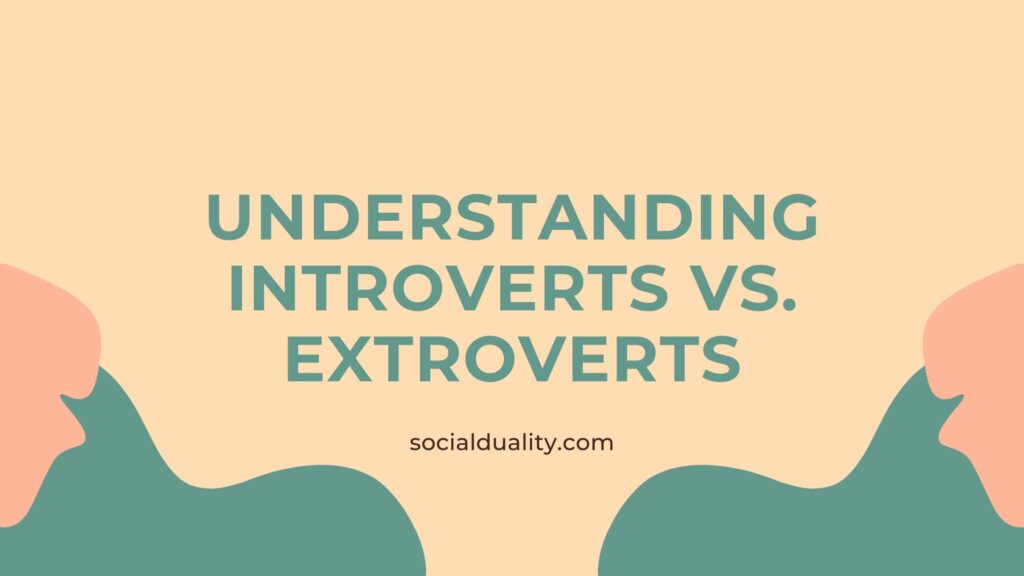Diving into the realm of personality types, we often find ourselves tangled in the classic debate of introverts vs. extroverts. At the heart of social psychology, understanding these personality traits reveals much about how we interact, recharge, and view the world around us. Carl Jung introduced us to the concepts of extroversion and introversion, laying the groundwork for what would become a cornerstone of positive psychology.
Introverts and extroverts exhibit distinct differences in social interaction and energy sources. While extroverts tend to draw energy from being around others, thriving in social settings, introverts find solace and re-energize in solitude. This doesn’t merely sketch a binary; human personality embodies a spectrum, acknowledging individual differences.
Understanding these dynamics enriches our grasp of psychology, offering insights into personality types that challenge or complement our own. Engaging with positive psychology exercises can illuminate paths to harnessing our innate tendencies, whether you identify with being an introverted extrovert or find yourself somewhere in between. As we explore these concepts, we tap into social psychology‘s rich tapestry, aiming to explain the intricacies of our social fabric.
Key Takeaways
- Introverts and extroverts have unique ways of interacting with the world, with extroverts drawing energy from social settings, while introverts recharge in solitude. This difference is pivotal in understanding human personality and social psychology.
- The introvert-extrovert spectrum highlights that personality is not a binary; rather, it involves a range of individual differences, suggesting that someone can exhibit traits of both ends, known as an introverted extrovert.
- Carl Jung‘s theories on extroversion and introversion form the basis of much current thinking in psychology, emphasizing the importance of these concepts in positive psychology to understand oneself and improve social interaction.
- Engaging with positive psychology exercises can help both introverts and extroverts harness their personality traits for personal and professional growth, emphasizing the practical application of understanding personality types.
- Cultural impact and workplace dynamics show how societal settings value or challenge extroverts and introverts, influencing how personality types navigate social environments and relationships, underscoring the relevance of psychology in everyday life.
Understanding Introverts: Defining the Personality
Delving into the complexities of introverts and extroverts, it’s essential to explore how these personality types play a pivotal role in social psychology. Carl Jung regarded extroversion and introversion as fundamental to our understanding of human personality, highlighting vast individual differences. This exploration is not just academic; it’s a tool for better social interaction and self-awareness, fostering a deeper appreciation for the psychology behind our personality traits.
Top 5 Traits of Introverted Individuals
Exploring the five key characteristics unique to introverts reveals much about how they navigate the world differently from extroverts. Firstly, introverts relish deep conversations over small talk, finding meaning in thoughtful dialogue. They often prefer solitude to recharge, valuing quiet moments for personal reflection. Sensitivity to stimulation means crowded places can be overwhelming, leading them to seek tranquil environments. Lastly, their creative independence shines when they’re given space to explore ideas without external pressure, highlighting the rich inner life of an introvert.
Grasping Extroverts: Exploring the Personality
Unpacking the essence of extroverts reveals a vibrant tapestry of personality traits that contrasts sharply with introverted tendencies. Where extroverts tend to thrive on social interaction, drawing energy from being around others, they also exhibit a dynamic approach to life that embraces extroversion. This inclination not only shapes their personal and professional relationships but also highlights the nuanced spectrum of human personality. An open psychometrics test can offer insights into where one might fall on this spectrum, providing a deeper understanding.
Top 5 Traits of Extroverted Individuals
Focusing on the five main characteristics of extroverts showcases how they excel in social settings, enjoying the energy and dynamism of group interactions. Unlike introverts, they are quick to express thoughts and feelings, often finding solitude less appealing than active engagement. Their knack for making connections easily plays a pivotal role in forming networks. Extroverts typically embody optimism, viewing challenges as opportunities, a trait supported by positive psychology. This enthusiasm for life underscores their bold approach to both personal and professional realms.
The Introvert-Extrovert Spectrum: Not Black and White
The spectrum of introversion and extroversion illustrates that personality is not a matter of black or white. Each individual falls somewhere along this continuum, blending traits from both ends. For instance, someone might be an introverted extrovert, enjoying social interactions but requiring time alone to recharge. This mix affects not only personal but also professional dynamics, underscoring the psychology behind our social interaction patterns.
How Introversion and Extroversion Intersect
The intersection between extroversion and introversion uncovers a fascinating blend within personality psychology. While Carl Jung introduced these concepts, modern positive psychology extends them, noting how both extroverts and introverts contribute unique strengths to social dynamics. Recognizing this mix, often seen in the introverted extrovert, enriches our grasp of human personality, empowering us to navigate social interactions more effectively.
Introverts and Extroverts: The Psychological Perspective
From the psychological viewpoint, the concepts of extroversion and introversion provide a rich framework to explain the variances in personality type. Carl Jung regarded these personality traits as fundamental to understanding individual differences in social interaction. It’s not just about being outgoing or reserved; it’s about how people recharge, process, and engage with the world around them. For those intrigued by how these traits influence behavior, Introvert Dear offers an in-depth exploration.
Carl Jung’s Influence on Introvert and Extrovert Theory
The sway of Carl Jung on the dichotomy between introversion and extroversion has profoundly shaped our understanding of personality. By distinguishing the energetic dynamics of extroverts from the reflective nature of introverts, Jung paved the way for a deeper exploration into human personality. This groundwork has been crucial for developments in positive psychology, offering a lens to view individual differences in social interaction more clearly.
The Brain’s Role in Introversion and Extroversion
Examining how the brain influences introversion and extroversion reveals intriguing insights into personality types. Research suggests extroverts tend to seek out social scenarios more aggressively due to differences in their reward systems, contrasting with introverts who may find excessive stimulation less rewarding. This divergence extends beyond mere preference, affecting everything from social interaction routines to energy management strategies. It’s a compelling piece of the psychology puzzle, offering a window into the personality underpinnings that shape our lives.
Introverts and Extroverts in Social Settings
Navigating the nuances between extroverts and introverts in social settings unveils how each personality type manages energy and engagement. While extroverts tend to thrive on interaction, drawing energy from being around others, introverts might find such encounters draining, preferring solitude to recharge. This distinction is pivotal for understanding social interaction dynamics, as highlighted by positive psychology. For those keen on exploring deeper, a study by Carrigan here offers further insights.
Navigating Relationships: Introverts vs Extroverts
Stepping through the delicate dance of forming and maintaining relationships with introverts and extroverts requires a keen understanding of personality dynamics. While extroversion brings a vibrant energy to interactions, introversion offers depth and thoughtfulness. Embracing these differences enriches our connections, making every moment count. Jung regarded extroversion and introversion as complementary, a perspective supported by positive psychology, which suggests that a balance between the two can lead to more fulfilling social experiences.
Workplace Dynamics: Introverts and Extroverts at Work
In the realm of workplace dynamics, the interplay between introverts and extroverts significantly shapes team interactions and productivity. Recognizing and valuing the distinct approaches to extroversion and introversion can transform a group’s efficiency. While extroverts may excel in brainstorming sessions, introverts often bring thoughtful insights during quieter moments. Bridging these styles fosters a collaborative environment where every personality thrives. For a deeper understanding of how these traits influence behavior, refer to Simply Psychology.
Cultural Impact on Introversion and Extroversion
The influence of culture on the spectrum between introversion and extroversion is vast and varied. Societal norms often dictate the value placed on either trait, affecting how individuals navigate their environments. In some cultures, being an extrovert is celebrated, aligning with communal and outgoing social structures. Conversely, other societies might prize the reflective and quieter nature of introverts, viewing it as a sign of wisdom. This dichotomy illustrates how cultural contexts can amplify or suppress aspects of our personality, shaping not just our social interactions but our self-perception over time. For those interested in the intersection of psychology and culture, Madison Diaz offers further reading on this topic.
6 Validated Tests to Determine Introversion and Extroversion
To identify where one falls on the spectrum of introversion and extroversion, six validated assessments offer insight. These tools measure various aspects of personality, focusing on extroversion and introversion tendencies. For instance, the free positive psychology resources incorporate scales that explain these traits in depth. Viewers seeking a comprehensive understanding might find Madison Diaz’s blog post enlightening. Their exploration into psychology emphasizes the significant role social preferences play in shaping our introverted or extroverted behaviors over time.
The Ambivert: A Blend of Introvert and Extrovert
Unraveling the mix of introvert and extrovert traits reveals a unique personality class known as the introverted extrovert. This fusion allows individuals to harness extroversion in lively settings while appreciating quiet moments, reflective of introverts. Such a blend offers versatility in both social and solitary scenarios, embodying the best of both worlds. For those curious, simply psychology and free positive psychology resources provide deep dives into this phenomenon, enriching understanding.
Transitioning Personalities: Can Introverts Become Extroverts?
Is it feasible for introverts to shift towards extroversion? This question taps into deep-rooted psychology and the understanding of personality development over time. While an outright transformation might seem like a tall order, individuals can indeed expand their social comfort zones. By engaging in activities that challenge their preferences, introverts can cultivate qualities associated with extroversion. This process, however, doesn’t erase their innate introvert tendencies but rather enriches their personality spectrum, allowing for a more adaptable approach to various scenarios.
Unfolding the Introverted Extrovert Phenomenon
Exploring the blend of introversion and extroversion unveils a personality dynamic often overlooked. Jung regarded extroversion as outward-facing energy, yet when introverts exhibit socially engaging behaviors, it sparks intrigue. This hybrid, seldom fitting neatly into one category, demonstrates the fluidity of personality over time. For those aiming to explain this duality, psychology offers insights into how social environments can influence one’s leaning between these traits, suggesting a spectrum rather than fixed categories.
3 Free Positive Psychology Exercises for Introverts and Extroverts
For those spanning the range of extroversion and introversion, three engaging exercises promise growth on a personal level. One method encourages journaling, a space for introverts to reflect and extroverts to process experiences. Another involves structured social time, balancing the need for interaction and solitude. Lastly, role-play scenarios can stretch comfort zones, beneficial for all personality types. Scott Barry Kaufman’s insights on Carrigan 1960 offer a deeper dive.
Applying Positive Psychology: Tools for Introverts and Extroverts
Harnessing the principles of psychology to benefit both introverts and extroverts demands a nuanced approach. Jung regarded extroversion as a key factor in personal growth, yet a balance with introversion is crucial. By creating environments where both personality types thrive, individuals can leverage their social strengths and manage time effectively. Practical strategies, such as mindful listening for extroverts and public speaking practice for introverts, underscore the importance of adaptable social skills.
TED Talks that Shed Light on Introverts and Extroverts
TED Talks offer a unique window into the dynamics of introverts and extroverts, providing a platform to explain the intricate dance between extroversion and introversion. These presentations dive into the psychology behind personality types, emphasizing the importance of understanding both introverted and extroverted behaviors in social settings. By highlighting real-life examples and expert analysis, viewers gain insights into balancing their personal and professional lives, regardless of where they fall on the spectrum.

